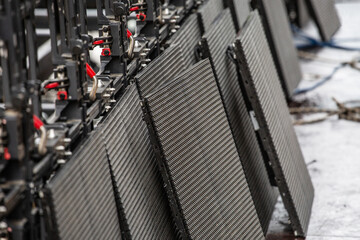LED Screen Walls are a popular choice for event planners looking to create captivating visual displays that can be used for multiple purposes. Led Screen Walls provide a seamless transition between different graphics and are easy to customize. However, there are a few things that you should consider before making your purchase. This includes size, pixel pitch, refresh rate, and software.

LED Screen Walls are large screens with light-emitting diodes that display visual content like videos, images, and text. They give the impression of a massive, luminous wall without any junctions between ranges of modules that make up the whole wall. The size of these screens depends on the purpose, resolution, and venue that they are going to be used in. The best way to decide is by consulting with an expert.
For example, if you are looking for a mobile application, the screen should be able to be rolled up and moved with ease. Also, if you are planning an indoor event, the screen should be able to be installed inside. Another important factor to consider is the brightness of the LED video wall. These displays tend to be much brighter and consume less power than projectors. This is because they don’t use lux as a measurement of reflected light, but rather NIT, which gauges direct light.
Pixel pitch is a key factor in the resolution of LED screen walls. The closer the individual pixels are to each other, the crisper the image will be at a distance.
LED screens are used for a wide variety of applications, including commercial television displays, video walls, digital signage, billboards and sports arenas. However, the quality of any display depends on a number of factors including the pixel pitch, size and viewing distances.
Generally, the lower the pixel pitch, the higher the potential resolution. Using standard rules of thumb, 1080p resolution is available for most LED wall applications.
The refresh rate of LED Screen Walls is an important factor in determining the quality of video displayed on them. This rate measures how many times per second that the hardware redraws an image on the screen. The more times a refresh is redrawn, the smoother the picture. This is a key factor in fast motion processing and can help prevent the display from flickering. Refresh rates can be measured in hertz (Hz). A high refresh rate means that the display can redraw an image thousands of times per second. This makes it ideal for high-speed action movies and esports.
LE犀利士5mg D screen walls are used in many industries, such as hotels and restaurants, as well as amusement parks. They can provide a captivating visual experience for guests and are easily customizable. They can be hung or mounted from truss, pipe grid, or ground support systems. DVS offers a wide range of screens that will work with the mounting type you choose.
The software used to create LED Screen Walls is browser-based and easy to configure. It has a single UI that automatically identifies the number of displays connected and allows anyone to create a virtual wall with no need for dedicated training.
If you want to set up the LED wall with a specific camera perspective, you need to specify the spatial information of each camera input. A camera tracking system normally provides this, but you can also specify it manually. Then you can use the UI to switch between these cameras in sync.
It is important for everyone to understand the value of LED upgrades in the business. While LED lights were originally invented to replace incandescent bulbs in hand held devices, they have now been developed into a power source for all kinds of appliances. Businesses that make use of a lot of machinery that needs to work at optimum capacity should consider investing in LEDs. The following are some of the main benefits of integrating an LED into your workplace.
An LED upgrade will not only eliminate the possibility of a hot spot, but will prevent sparks from starting too often. The problem with an inefficient or non-functional LED bulb is that it can easily start a fire if it is in a particularly hot area. This type of spark occurs when the filament in the bulb begins to overheat. Replacing the old inefficient bulbs with new LED bulbs with a sharp cutoff will help to prevent this overheat.
